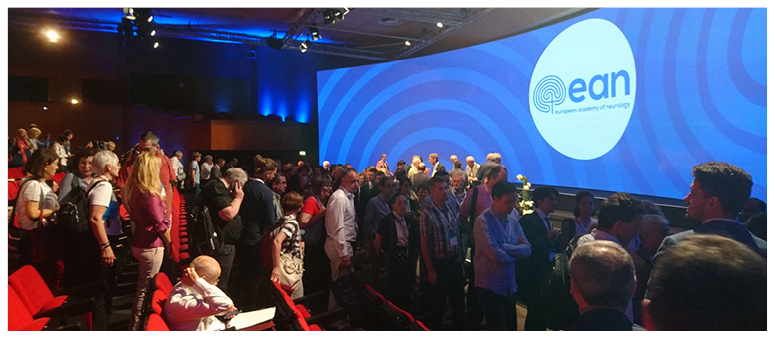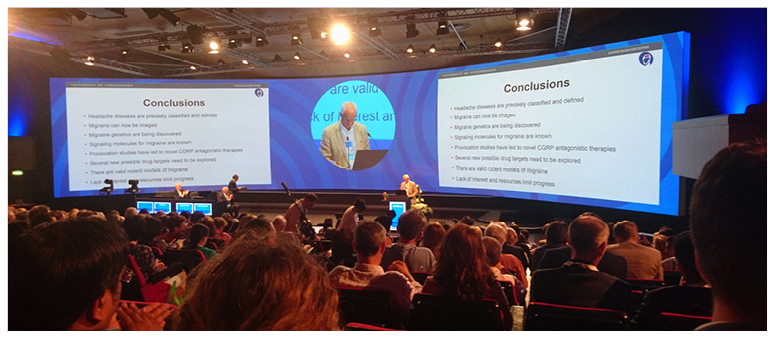Summary of the EAN 2018 Presidential Symposium
During this year’s EAN Congress, the EMJ team attended the much-anticipated final presidential symposium chaired by Prof Günther Deuschl as President of the EAN, and we bring to you our own summary of the pioneering findings presented during this thought-provoking symposium on 17th June 2018. Greeted by a rousing applause from a packed auditorium, Prof Deuschl welcomed the audience and commented on the astonishing findings about to be shown in a series of presentations encompassing hot topics at the pinnacle of neurology research, including multiple sclerosis (MS) and its link with gut microbiota, the impact of biomarkers on Alzheimer’s disease (AD), and drug development in migraine treatment.
Immune Pathogenesis of Multiple Sclerosis: Degeneration, Inflammation, and Gut Microbiota
Setting out to educate the audience on the link between MS and gut microbiota, Dr Hartmut Wekerle, Max Planck Institute of Neurobiology, Munich, Germany, began by explaining that the link between neurodegeneration and inflammation has long been established, first described 140 years ago during studies of MS plaques. The more poignant question now is one similar to that of the chicken and the egg: what comes first? Is inflammation caused by neurodegeneration or vice versa?
Dr Wekerle explained that inflammation in the brain is somewhat of a paradox. The healthy brain environment is a hostile place for inflammatory molecules, deficient of all components necessary for inflammatory cells to proliferate. However, this is drastically altered when observing neurodegenerative disease lesions, including AD, Parkinson’s disease, and amyotrophic lateral sclerosis, in which the brain becomes a more hospitable environment for such molecules. Dr Wekerle highlighted that microglia are the crux to this change. Microglia are always present in the brain and under normal circumstances they are dormant; however, when neurons lose their suppressive effect, the microglia become active. This can occur when mitochondria are released during necrosis, due to misfolded proteins commonly seen in neurodegenerative diseases, or as a result of the microbiota.
Bringing us to the cornerstone of the presentation, Dr Wekerle presented many cases linking gut microbiota to neurodegenerative diseases from 2015 until more recently in 2018. One of which involved the study of a transgenic murine model that had cloned myelin autoimmune T cell receptors incorporated into the genome.1 These mice showed axonal destruction with spontaneous relapsing remitting disease, similar to that experienced by early-stage MS patients, highlighting the strong link between gut microbiota and the onset of neurological-like symptoms.
Dr Wekerle addressed the concerns of some researchers regarding the translation of these murine model studies to the clinic by highlighting a study of monozygotic twins,2 one of whom had MS and the other was unaffected. Faecal transplants from each twin were transplanted into germ-free mice. The results were remarkable; a faecal transplant from the MS twin triggered spontaneous relapsing remitting MS-like disease in the mice, while the transplant from the unaffected twin had no effect. This study shows just how interlinked the onset of MS and gut microbiota are, potentially offering a new line of treatment for MS patients.
The closing address of Dr Wekerle’s presentation focussed on the future of these therapeutic options. He suggested that antibiotic or phage therapies could be used to remove the bacteria causing inflammation in the brain and reduce the subsequent neurodegeneration, as could dietary modifications or faecal transplants. He did, however, advise against these therapies at present until further clinical studies are conducted, noting that more research is needed to ascertain whether these therapies will have a safe and efficacious effect for those living with MS.

The Evolution of Alzheimer’s Disease and Dementia
The spotlight was then placed on Prof Philip Scheltens, Alzheimer’s Center, Amsterdam, Netherlands, whose presentation focussed on how biomarkers have changed the field of dementia. He began by expressing what an honour it was to present to such a varied neurological audience on a topic that he believes is so important to the progression of AD research and treatment, as well as dementia as a whole. Prof Scheltens described dementia as an illogical disease and emphasised the pivotal role biomarkers continue to play in the development of this field.
The 2018 Brain Prize winners, John Hardy, Bart de Strooper, Christian Haass, and Michel Goert, were all highly praised by Prof Scheltens for their work on dementia genetics, secretases, and tau genetics and proteins. Prof Scheltens noted that this area of research is fully deserving of such highly prestigious accolades due to the relatively infantile stage that research is currently at in regard to understanding these complex diseases. He reminded the audience that we are only at the beginning of this exciting and momentous journey and there is still much to learn.
Prof Scheltens continued his presentation by highlighting how far neurology research into dementia has progressed; only 30 years ago fludeoxyglucose positron emission tomography (FDG-PET) was used to diagnose dementia, but now biomarkers have changed the whole concept of disease management. Prof Scheltens took the audience through the evolution of biomarkers in dementia and AD: from the 1980s using FDG-PET scans to identify AD brains to 1986 with the introduction of hippocampus CT imaging, fast forwarding to 1992 with the evolution of the coronal MRI slices, and then to more recently in 2004 with the first amyloid imaging used to show amyloid proteins with PET scans. Prof Scheltens highlighted that tau images are also unique between AD patients and commented that their future use in clinical trials as an outcome measurement in AD is bright.
Prof Scheltens then walked the audience through the development of AD diagnosis and the concept change surrounding this development. Decades ago, the only way to diagnose AD was during a post-mortem when a clinician could view the amyloid plaques in the brain. Of course, this was very unhelpful in the development of diagnosis and treatment methods. Then, in 1984, only 34 years ago, criteria were released that allowed AD diagnosis in vivo.3 Listing symptoms and enabling exclusion of other disorders, such as tumours, was undoubtedly a step in the right direction for AD diagnosis. However, Prof Scheltens did note that there was no other basis of diagnosis, such as biomarkers, which made diagnosis subjective and did not help extend the understanding of the biological basis of the disease or allow prediction of AD.
These criteria were built upon by incorporating biomarkers, allowing for a more specific diagnosis and enabling the clinician to distinguish between dementia syndromes.4 In 2014, further refining was executed to separate typical and atypical phenotypes.5 Furthermore, a 2018 collaboration between the European Union (EU) and USA was based on pathological hallmarks of AD (amyloid and tau), allowing biomarkers rather than symptoms to direct diagnosis.
Prof Scheltens closed his presentation by commenting on the clinical impact of biomarkers, including how to use them effectively and how they will impact on drug development. Diagnostic impact was a cornerstone of the clinical impact of biomarkers. Results of a study presented showed that 7% of clinicians changed their original diagnosis once they were given access to pathological biomarker tests of AD.6 This may seem a small percentage, but the impact this would have on a patient’s treatment and prognosis is staggering. It is not only diagnosis that biomarkers can impact; they can also be informative of disease progression and prognosis, allowing patients to be better informed and prepared for what their disease decline is likely to entail in the years to come. Prof Scheltens also mentioned the development of an app that takes into account specific patient information and biomarkers to aid clinicians in deciding whether a test would be worth conducting.
Lastly, Prof Scheltens commented on what still needs to be addressed in the ever-evolving field of biomarkers in dementia, including analytical issues, ethical issues, and education. There is an enormous window of opportunity for the development of personalised treatment of AD patients and Prof Scheltens emphasised the imperative need to detect dementia early, ideally >20 years before symptom onset, to properly tackle this debilitating and life-changing disease. In his closing remarks, Prof Scheltens addressed his colleagues directly, stressing the importance of investing in young researchers and nurturing their development in this fast-paced, pioneering field.
Migraine: From Basic Research to New Drugs
During the final presentation of this engaging and thought-provoking presidential symposium, Prof Jes Olesen, University of Copenhagen, Copenhagen, Denmark, took to the stage. He highlighted the importance of migraine research, with a recent global burden of disease study ranking migraine the second most burdensome disease, and noted the difficulty in studying the disorder due to no neurological changes being visible during examination.7 Prof Olesen referred back to Prof Scheltens’s presentation on the importance of biomarkers, commenting that there are no biomarkers for migraine, making it particularly difficult to diagnose early.
Prof Olesen discussed the current understanding of migraine genetics and its impact, or lack of, on the advancement of migraine treatment. He used familial hemiplegic migraine as an example of how the identification of three genes (FHMI 1, 2, and 3), known to be dominantly inherited and associated with calcium channels, the potassium-sodium ADPase, and sodium channels, led to no new treatments for this form of migraine. This is echoed by many migraine disorders; 42 genome-wide significant loci have previously been identified but, despite giving a deeper understanding into the mechanism of migraine, they have not identified any novel drug targets. Ongoing studies are underway assessing polygenic risk score in relation to patient responses to drugs; however, Prof Olesen reiterated that while these studies will no doubt help advance the treatment of migraine towards the era of personalised medicine, they are unlikely to identify new drug targets.
Prof Olesen then proceeded by explaining how researchers are attempting to identify new drug targets through a number of different models. The first model presented was the very old cortical spreading depression (CSD) model,8 which allowed researchers to identify that migraine with aura was caused by CSD. This model is now used in animal models and has allowed the development of tonabersat, which reduced attacks of migraine with aura by 75% in patients. With such promising results, why did this apparently effective drug not progress to patents? Prof Olesen answered his own question: tonabersat had a very short patent and, coupled with the fact that there are so few patients effected by migraine with aura frequent enough that they required this type of treatment, no pharmaceutical company thought the drug was worthy of developing.
The second model described to the audience was the human provocation model, which Prof Olesen described as an interesting and exciting model due to its totally unique utility in migraine research. The model induces a migraine attack in a volunteer that allowed researchers to observe physiological effects of migraine, particularly in the major arteries. This type of induction of a condition would have never been ethically viable in other neurological disorders but, due to the repressible nature of migraine, it has allowed a truly unique research angle to be explored. Using the human provocation model, 20 years ago nitroglycerin infusion was found to induce a migraine attack 5–7 hours later.9 Nonselective inhibition of nitric oxide production by inhibiting nitric oxide synthase enzymes was found to effectively treat mild migraine; however, such nonselective inhibition would never be tolerated in a real-word environment because the side effects would be too numerous, and, as such, the development of a selective nitric oxide synthase inhibitor is still urgently needed.

The much more productive calcitonin gene-related peptide (CGRP) model identified the vasodilator molecule CGRP, located in the sensory nerves, which has strong vasodilating effects on cranial circulation. As such, this molecule is of great interest to researchers and has since been found to induce migraine attack, offering a potential novel drug target. Studies found that CGRP-induced artery diameter increase was fully blocked by the CGRP receptor antagonist olcegepant.10 During clinical trials, olcegepant was also shown to be effective at preventing acute migraine attacks, with a 60–70% efficacy at a dose range of 2.5–10.0 mg.10 Despite olcegepant not reaching patients, Prof Olesen was optimistic, stating that olcegepant has shown proof of concept that a CGRP receptor inhibitor could offer effective and safe preventative treatment for migraine patients. Indeed, patients who had received olcegepant and were then infused with CGRP exhibited no vasodilating effects and no migraine was induced. Prof Olesen further demonstrated his optimism for CGRP receptor inhibitors by noting the development of four monoclonal humanised antibodies, three of which bind to CGRP itself and one binds to the CGRP receptor to prevent its effect. He stated that the most exciting and promising drug, erenumab, is already on the market in the USA and is expected to be marketed throughout Europe by the end of 2018, offering a novel treatment for those affected by migraine.
The fourth and final model presented by Prof Olesen was the pituitary adenylate cyclase activating peptide (PACAP) molecule model. PACAP has been shown to induce an immediate headache along with a delayed migraine, allowing the identification of the PAC1 receptor that is solely activated by PACAP, another potential drug target. As of yet, there are no data regarding PAC1 receptor inhibitors and their effect on migraine patients; however, there is an ongoing monoclonal antibody trial, the results of which are hotly anticipated by the migraine community.
Prof Olesen acknowledged the wonderful and effective results monoclonal antibodies can have as a therapeutic option due to their selectiveness and minimal side effects; however, he highlighted that there are still gaps to be filled. Addressing the gaps in migraine therapy, Prof Olesen hinted that one of his colleagues, Prof Messoud Ashina, University of Copenhagen, Copenhagen, Denmark, is working on an incredibly exciting therapeutic target that could rival the importance of PAC1; however, he stopped himself from further explaining the much-anticipated results because they are still unpublished. Here at the EMJ we are definitely looking forward to reading these stimulating results when they are available.
As the session was beginning to draw to a close, Prof Olesen emphasised the importance of animal models for drug discovery and development because companies considering investing in and developing a drug need to be presented with in vivo results. Migraine research has a well-researched rat model: STA rats. STA rats have a very low pain threshold in their head, which allows drugs to be tested to assess whether their pain threshold changes. Both sumatriptan, which acts on 5C1β receptors, and olcegepant have been shown to improve a STA rat’s pain threshold in their head compared to their hind paw.11 These rats present opportunities to test new drugs in animal models before presenting them to pharmaceutical companies, hopefully allowing the more successful development of novel drugs that will reach patients in the real-world environment.
Concluding the presidential symposium at the 4th EAN Congress, Prof Olesen stated that although headache disorders are well classified and defined, and there is a greater understanding of the genetics and signalling that underpins migraine disorders than ever before, the lack of interest and resources are the biggest hindrance to the advancement of migraine therapy.
The EMJ team thoroughly enjoyed attending this presidential symposium and eagerly await the exciting new results that will be presented at next year’s EAN Congress in Oslo, Norway.








